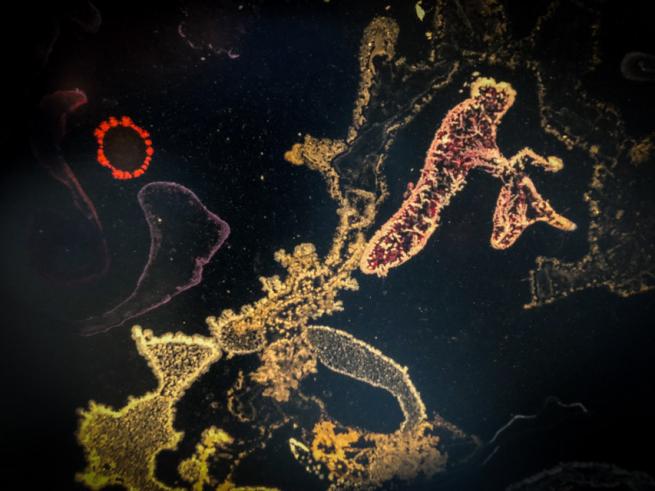New artwork honors the work of Professor Emeritus Poul Erik Hansen

The picture Chemophilia 1 is a donation from the Chemistry Research Group presented to Professor Emeritus Poul-Erik Hansen to celebrate his 75th birthday and to honor his long-standing scientific carreer. As the name indicates, the artwork is also a homage to chemistry. Instead of the use of conventional paint and canvas, the artist Thomas Ruhland has crystallized various chemicals onto a black glass plate.
All chemicals used, have played a pivotal role in Poul-Erik Hansens research and possess beautiful molecular architectures. To those belong for example cyclic sugar molecules (cyclodextrins), the aromate pyrene, and salts of the violuric acid. All chemicals used have a high boiling point and are sealed within the frame and therefore ensure the safety for viewer and environment.
Artist and chemist with strong ties to Roskilde University
Thomas Ruhland (b. 1962) is a German artist and chemist. He has worked nearly 15 years in the pharmaceutical industry as medicinal chemist and is particularly known for his synthetic discovery of the antidepressant Trintellix. Thomas Ruhland has also for longer periods of time contributed with his expert knowledge teaching organic and bioorganic chemistry as a Part-time Lecturer at Roskilde University.
Usually, chemicals are stored in flasks and hidden in chemistry laboratories. In the new artwork, however, they are exposed in public, and the artwork illustrates the aesthetics of chemistry. By this, the artist intends to awake the interest and fascination in chemistry, not least amomg students:
“If the picture can help students to become motivated and passionated, amazing things can happen. Some of them might contribute to the development of new medicines, of green production processes, or of innovative materials. In other words, they will shape our future society – hopefully for the better”, says Thomas Ruhland.
Art as social sculpture
For Thomas Ruhland the passion for art all started when he personally met the German artist Joseph Beuys in 1982. This gave Thomas Ruhland the chance to discuss Joseph Beuys’s unique perception of art that goes beyond the traditional understanding of art by shaping or creating pictures and sculptures. For Joesph Beuys, art is also the conscious and active participation in shaping society, which he names social sculpture.
“Meeting Joseph Beuys had a profound impact on my carreer as both an artist and a chemist and the two became inextricably linked together and inspired me in my academic work which eventually let me to the synthetic discovery of the antidepressant Trintellix”, says Thomas Ruhland.
The artwork Chemophilia 1 by Thomas Ruhland can be seen at its permanent location at Roskilde University, building 28A.
About Poul Erik Hansen
Poul Erik Hansen was employed at Roskilde University in 1976 and appointed professor of Chemistry in 1996. He retired in 2017 but as a Professor Emeritus he continues to be an active researcher and colleague at the Department of Science and Environment. His research is concentrated on nuclear magnetic resonance, infra red spectroscopy, theoretical calculations, isotope effects, hydrogen bonding, natural product and studies of biologically interesting compounds like usnic acid and curcumin.